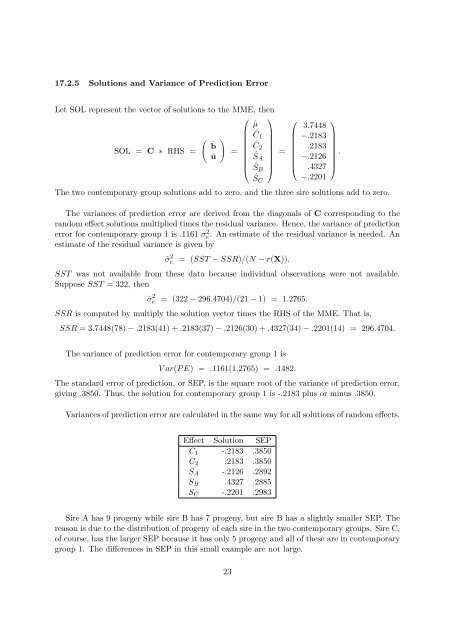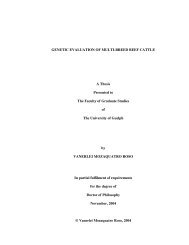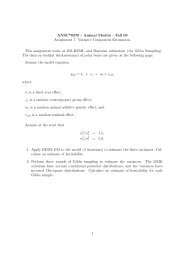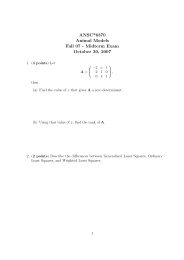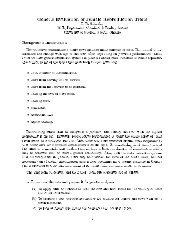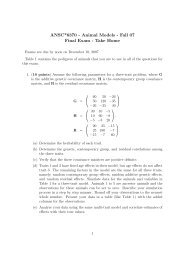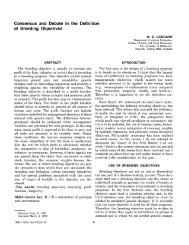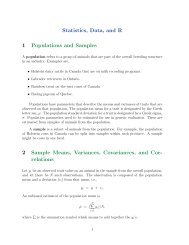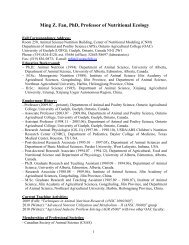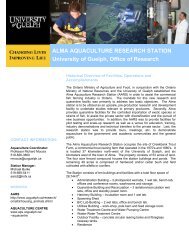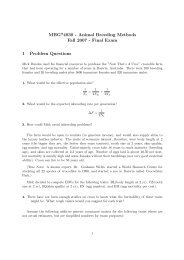Prediction Theory 1 Introduction 2 General Linear Mixed Model
Prediction Theory 1 Introduction 2 General Linear Mixed Model
Prediction Theory 1 Introduction 2 General Linear Mixed Model
Create successful ePaper yourself
Turn your PDF publications into a flip-book with our unique Google optimized e-Paper software.
17.2.5 Solutions and Variance of <strong>Prediction</strong> Error<br />
Let SOL represent the vector of solutions to the MME, then<br />
⎛ ⎞<br />
ˆµ<br />
( )<br />
Ĉ 1<br />
ˆb<br />
SOL = C ∗ RHS = =<br />
Ĉ 2<br />
û<br />
Ŝ A<br />
⎜ ⎟<br />
⎝ ŜB ⎠<br />
ŜC<br />
=<br />
⎛<br />
⎜<br />
⎝<br />
3.7448<br />
−.2183<br />
.2183<br />
−.2126<br />
.4327<br />
−.2201<br />
The two contemporary group solutions add to zero, and the three sire solutions add to zero.<br />
The variances of prediction error are derived from the diagonals of C corresponding to the<br />
random effect solutions multiplied times the residual variance. Hence, the variance of prediction<br />
error for contemporary group 1 is .1161 σ 2 e. An estimate of the residual variance is needed. An<br />
estimate of the residual variance is given by<br />
ˆσ 2 e<br />
= (SST − SSR)/(N − r(X)).<br />
SST was not available from these data because individual observations were not available.<br />
Suppose SST = 322, then<br />
ˆσ 2 e = (322 − 296.4704)/(21 − 1) = 1.2765.<br />
SSR is computed by multiply the solution vector times the RHS of the MME. That is,<br />
SSR = 3.7448(78) − .2183(41) + .2183(37) − .2126(30) + .4327(34) − .2201(14) = 296.4704.<br />
⎞<br />
.<br />
⎟<br />
⎠<br />
The variance of prediction error for contemporary group 1 is<br />
V ar(P E) = .1161(1.2765) = .1482.<br />
The standard error of prediction, or SEP, is the square root of the variance of prediction error,<br />
giving .3850. Thus, the solution for contemporary group 1 is -.2183 plus or minus .3850.<br />
Variances of prediction error are calculated in the same way for all solutions of random effects.<br />
Effect Solution SEP<br />
C 1 -.2183 .3850<br />
C 2 .2183 .3850<br />
S A -.2126 .2892<br />
S B .4327 .2885<br />
S C -.2201 .2983<br />
Sire A has 9 progeny while sire B has 7 progeny, but sire B has a slightly smaller SEP. The<br />
reason is due to the distribution of progeny of each sire in the two contemporary groups. Sire C,<br />
of course, has the larger SEP because it has only 5 progeny and all of these are in contemporary<br />
group 1. The differences in SEP in this small example are not large.<br />
23


